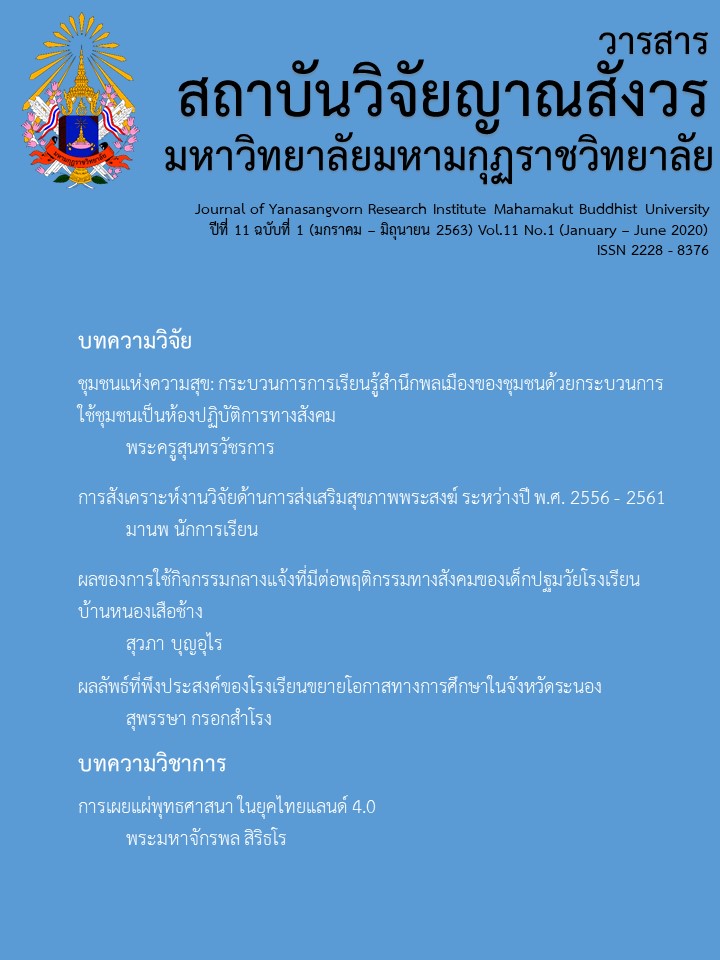ACTIVE LEARNING FOR INDEPENDENT STUDY
Main Article Content
Abstract
Active learning course is created to engage students in collaborative activities, thinking process development and viewpoint sharing. Furthermore, students play an important part to gain their own knowledge which is consistent with ‘Five Steps for Student Development’, the international standard for independent study. The objectives of this article are to present definition, concept and characteristic of active learning. Also, learning formats, the role of an instructor, and example of independent study with active learning will be provided.
Article Details
How to Cite
Klyprayong, R. . (2020). ACTIVE LEARNING FOR INDEPENDENT STUDY. Journal of Yanasangvorn Research Institute Mahamakut Buddhist University, 11(1), 104–113. retrieved from https://so04.tci-thaijo.org/index.php/yri/article/view/244035
Section
Academic Article
References
กระทรวงศึกษาธิการ. (2551). หลักสูตรแกนกลางการศึกษาขั้นพื้นฐาน พุทธศักราช 2551. กรุงเทพมหานคร: ผู้แต่ง
ทิศนา แขมมณี. (2553). ศาสตร์การสอน : องค์ความรู้เพื่อการจัดกระบวนการเรียนรู้ที่มีประสิทธิภาพ (พิมพ์ครั้งที่ 13). กรุงเทพมหานคร: สำนักพิมพ์แห่งจุฬาลงกรณ์มหาวิทยาลัย.
สถาพร พฤฑฒิกุล. (2555). คุณภาพผู้เรียน...เกิดจากกระบวนการเรียนรู้. วารสารการบริหารการศึกษา มหาวิทยาลัยบูรพา, 6(2), 1-13.
สำนักงานเลขาธิการสภาการศึกษา. (2562). มาตรฐานการศึกษาของชาติ พ.ศ.2561. (พิมพ์ครั้งที่ 2). นนทบุรี: บริษัท 21 เซ็นจูรี่ จำกัด.
สำนักบริหารงานมัธยมศึกษาตอนปลาย สำนักงานคณะกรรมการการศึกษาขั้นพื้นฐาน กระทรวงศึกษาธิการ. (2555). แนวทางการจัดการเรียนการสอนในโรงเรียนมาตรฐานสากล ฉบับปรับปรุง. กรุงเทพมหานคร: โรงพิมพ์ชุมนุมสหกรณ์การเกษตรแห่งประเทศไทย จำกัด.
Bachman, L.R. and Bachman C.M. (2011). A study of classroom response system clickers: Increasing student engagement and performance in a large undergraduate lecture class on architectural research. Journal of Interactive Learning Research, 22(1), 5-21.
Berry, W. (2008). Surviving lecture: A pedagogical alternative. College Teaching, 56(3), 149-153.
Bonwell, Charles C. and Eison, James A. (1991). Active Learning: Creating Excitement in the Classroom. Washington DC: School of Education and Human Development, George Washington University.
Christianson, R. and Fisher, K. (1999). Comparison of student learning about diffusion and osmosis in constructive and traditional classroom. International Journal of Science Education, 21(6), 687-698.
Fedler, R. and Brent, R. (1996). Navigating the bumpy road to student-centered instruction. College Teaching, 44(2), 43-47.
Fosnot, C. (1992). Constructing Constructivism. New Jersey: Lawrence Erlbaum Associates Publishers.
Jonassen, D.H. (1992). Evaluating constructivist learning. New Jersey: Lawrence Erlbaum Associates Publishers.
Kirschner, P.S. and Clark, R. (2006). Why minimal guidance during instruction does not work: An analysis of the failure of constructivist, discovery, problem-based, experiential, and inquiry-based teaching. Education Psychologist, 41(2), 75-86.
Lee, P., Linh, N., and Thatong, S. (2017). Students’ Perceptions of the Lecture and Active Learning Methods in Teaching: A Study of Asian Students. Retrieved fromhttp://isc2017.apiu.edu/conference-papers/aiu/Lee%20et%20al. Perceptions. lecture.active.learning.Asians.pdf
Mayer, R. (2004). Should there be a three-strikes rule against pure discovery learning? The case for guided methods of instruction. American Psychologist, 59(1), 14-19.
O’Sullivan, D. and Cooper, C. (2003). Evaluating active learning: A new initiative for a general chemistry curriculum. Journal of College Science Teaching, 32(7), 448-452.
ทิศนา แขมมณี. (2553). ศาสตร์การสอน : องค์ความรู้เพื่อการจัดกระบวนการเรียนรู้ที่มีประสิทธิภาพ (พิมพ์ครั้งที่ 13). กรุงเทพมหานคร: สำนักพิมพ์แห่งจุฬาลงกรณ์มหาวิทยาลัย.
สถาพร พฤฑฒิกุล. (2555). คุณภาพผู้เรียน...เกิดจากกระบวนการเรียนรู้. วารสารการบริหารการศึกษา มหาวิทยาลัยบูรพา, 6(2), 1-13.
สำนักงานเลขาธิการสภาการศึกษา. (2562). มาตรฐานการศึกษาของชาติ พ.ศ.2561. (พิมพ์ครั้งที่ 2). นนทบุรี: บริษัท 21 เซ็นจูรี่ จำกัด.
สำนักบริหารงานมัธยมศึกษาตอนปลาย สำนักงานคณะกรรมการการศึกษาขั้นพื้นฐาน กระทรวงศึกษาธิการ. (2555). แนวทางการจัดการเรียนการสอนในโรงเรียนมาตรฐานสากล ฉบับปรับปรุง. กรุงเทพมหานคร: โรงพิมพ์ชุมนุมสหกรณ์การเกษตรแห่งประเทศไทย จำกัด.
Bachman, L.R. and Bachman C.M. (2011). A study of classroom response system clickers: Increasing student engagement and performance in a large undergraduate lecture class on architectural research. Journal of Interactive Learning Research, 22(1), 5-21.
Berry, W. (2008). Surviving lecture: A pedagogical alternative. College Teaching, 56(3), 149-153.
Bonwell, Charles C. and Eison, James A. (1991). Active Learning: Creating Excitement in the Classroom. Washington DC: School of Education and Human Development, George Washington University.
Christianson, R. and Fisher, K. (1999). Comparison of student learning about diffusion and osmosis in constructive and traditional classroom. International Journal of Science Education, 21(6), 687-698.
Fedler, R. and Brent, R. (1996). Navigating the bumpy road to student-centered instruction. College Teaching, 44(2), 43-47.
Fosnot, C. (1992). Constructing Constructivism. New Jersey: Lawrence Erlbaum Associates Publishers.
Jonassen, D.H. (1992). Evaluating constructivist learning. New Jersey: Lawrence Erlbaum Associates Publishers.
Kirschner, P.S. and Clark, R. (2006). Why minimal guidance during instruction does not work: An analysis of the failure of constructivist, discovery, problem-based, experiential, and inquiry-based teaching. Education Psychologist, 41(2), 75-86.
Lee, P., Linh, N., and Thatong, S. (2017). Students’ Perceptions of the Lecture and Active Learning Methods in Teaching: A Study of Asian Students. Retrieved fromhttp://isc2017.apiu.edu/conference-papers/aiu/Lee%20et%20al. Perceptions. lecture.active.learning.Asians.pdf
Mayer, R. (2004). Should there be a three-strikes rule against pure discovery learning? The case for guided methods of instruction. American Psychologist, 59(1), 14-19.
O’Sullivan, D. and Cooper, C. (2003). Evaluating active learning: A new initiative for a general chemistry curriculum. Journal of College Science Teaching, 32(7), 448-452.


